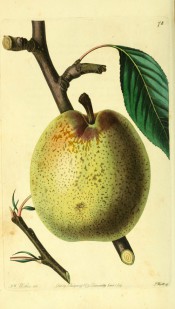Pyrus communis ‘Easter Beurré’
‘Fruit large, roundish oblong, broadest towards the eye, nearly four inches long, and three inches and a half in diameter. Eye small with a connivent calyx, sunk in a moderately deep depression. Stalk short, thick, sunk in a deep obtuse-angled cavity. Skin green, thickly mottled with small russetty dots; when ripe becoming yellowish, and coloured with brown, somewhat streaky, on the sunny side. Flesh whitish, inclining to yellow, perfectly buttery and melting, and extremely high-flavoured. In eating from November till May.’ [George Lindley – Orchard Guide p.393/1831].
Horticultural & Botanical History
‘In the gardens of the Capucin Monastery at Louvain, Belgium, there was, about 1823, an old pear tree known to the monks as the Pastorale de Louvain, which attracted the attention of Van Mons. He propagated the pear and in due course distributed it. By the year 1853, it was to be found pretty generally in the gardens of Belgium under the name of Pastorale. Since that time it has been very widely disseminated, but unfortunately has received a confusing variety of names, Leroy mentioning twenty-four and Mathieu fifty-five. The leading authorities, however, of England and this country have uniformly adopted the name Easter Beurré.’ [Pears of New York p.160].
John Lindley, writing in the Pomological Magazine, casts some doubt on the authenticity of some of the many synonyms. ‘The Beurré d'hiver de Bruxelles, a kind only described in the Taschenbuch, has proved in the Garden of the Horticultural Society to be this [‘Easter Beurré’]; as has also a variety received some years since from M. Stoffels, of Mechlin, under the name of Bezy Chaumontel très gros. It is probable, from this latter circumstance, that the origin of this kind was Flanders.
The Pear of this name described in the Horticultural Transactions, vol. v. in the Appendix, by M. Parmentier, is not here cited as a synonym, because it is characterised as a crisp fruit, which this never is; for a similar reason, the Bergamotte de Pentecôte of Van Mons's Arbres Fruitieres is omitted, that writer speaking of its musky flavour, a quality unknown in the subject of these remarks. It is observed by M. Noisette, that he thinks his Bergamotte de Pentecôte is the same as the Beurré Rancé of the Flemings. In this, however, he is certainly mistaken, as will be shewn in a future number of this work.’ [PM t.78/1829].
Also figured in the Herefordshire Pomona [HP pl.LXX/1878], Pomonia Brittanica [PB pl.LXXXV/1812] and Saint-Hilaire [pl.158/1829]. The pear figured in Pears of New York [p.160] is much more highly coloured than the fruit depicted elsewhere and is more elongated in shape, tapering towards the stalk. It may not be ‘Easter Beurré’.
‘Colour greenish-brown; form obovate; size large; quality excellent; tree hardy and a good bearer: altogether one of the most valuable keeping pears in cultivation. In use from April to June.’ [NHM vol.1 p79/1864].
History at Camden Park
Listed only in the 1857 catalogue in an Addendum as ‘Beurré Easter’ [Pear no.35/1857]. There is no diary entry for this pear.
Notes
Published May 19, 2010 - 03:12 PM | Last updated Jul 22, 2011 - 01:58 PM
| Family | Rosaceae |
|---|---|
| Category | |
| Region of origin | Garden origin, Belgium |
| Synonyms |
|
| Common Name | Dessert Pear, winter to spring |
| Name in the Camden Park Record |
Beurré Easter
|
| Confidence level | high |


